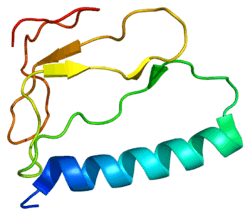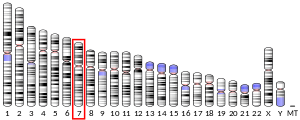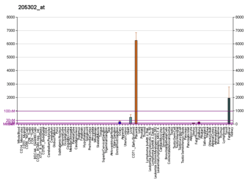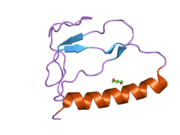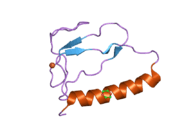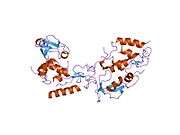IGFBP1
Insulin-like growth factor-binding protein 1 (IBP-1) also known as placental protein 12 (PP12) is a protein that in humans is encoded by the IGFBP1 gene.[5][6]
Function
This gene is a member of the Insulin-like growth factor-binding protein (IGFBP) family and encodes a protein with an IGFBP domain and a type-I thyroglobulin domain. The protein binds both insulin-like growth factors (IGFs) I and II and circulates in the plasma. Binding of this protein prolongs the half-life of the IGFs and alters their interaction with cell surface receptors. Alternate transcriptional splice variants, encoding different isoforms, have been characterized.[6]
gollark: STOP HIM!
gollark: What?
gollark: @everyone > <@!258639553357676545> > @everyone
gollark: @everyone > @everyone
gollark: Unless you're LyricLy.
References
- GRCh38: Ensembl release 89: ENSG00000146678 - Ensembl, May 2017
- GRCm38: Ensembl release 89: ENSMUSG00000020429 - Ensembl, May 2017
- "Human PubMed Reference:". National Center for Biotechnology Information, U.S. National Library of Medicine.
- "Mouse PubMed Reference:". National Center for Biotechnology Information, U.S. National Library of Medicine.
- Brinkman A, Groffen C, Kortleve DJ, Geurts van Kessel A, Drop SL (Jan 1989). "Isolation and characterization of a cDNA encoding the low molecular weight insulin-like growth factor binding protein (IBP-1)". EMBO J. 7 (8): 2417–23. PMC 457109. PMID 2461294.
- "Entrez Gene: IGFBP1 insulin-like growth factor binding protein 1".
Further reading
- Rajaram S, Baylink DJ, Mohan S (1998). "Insulin-like growth factor-binding proteins in serum and other biological fluids: regulation and functions". Endocr. Rev. 18 (6): 801–31. doi:10.1210/er.18.6.801. PMID 9408744.
- Ferry RJ, Cerri RW, Cohen P (1999). "Insulin-like growth factor binding proteins: new proteins, new functions". Horm. Res. 51 (2): 53–67. doi:10.1159/000023315. PMID 10352394.
- Firth SM, Baxter RC (2003). "Cellular actions of the insulin-like growth factor binding proteins". Endocr. Rev. 23 (6): 824–54. doi:10.1210/er.2001-0033. PMID 12466191.
- Wood AW, Duan C, Bern HA (2005). "Insulin-like growth factor signaling in fish". Int. Rev. Cytol. 243: 215–85. doi:10.1016/S0074-7696(05)43004-1. PMID 15797461.
- Ehrenborg E, Larsson C, Stern I, et al. (1992). "Contiguous localization of the genes encoding human insulin-like growth factor binding proteins 1 (IGBP1) and 3 (IGBP3) on chromosome 7". Genomics. 12 (3): 497–502. doi:10.1016/0888-7543(92)90440-4. PMID 1373120.
- Ekstrand J, Ehrenborg E, Stern I, et al. (1990). "The gene for insulin-like growth factor-binding protein-1 is localized to human chromosomal region 7p14-p12". Genomics. 6 (3): 413–8. doi:10.1016/0888-7543(90)90470-F. PMID 1691735.
- Suwanichkul A, Cubbage ML, Powell DR (1991). "The promoter of the human gene for insulin-like growth factor binding protein-1. Basal promoter activity in HEP G2 cells depends upon liver factor B1". J. Biol. Chem. 265 (34): 21185–93. PMID 1701175.
- Brinkman A, Kortleve DJ, Schuller AG, et al. (1991). "Site-directed mutagenesis of the N-terminal region of IGF binding protein 1; analysis of IGF binding capability". FEBS Lett. 291 (2): 264–8. doi:10.1016/0014-5793(91)81298-M. PMID 1718783.
- Brewer MT, Stetler GL, Squires CH, et al. (1988). "Cloning, characterization, and expression of a human insulin-like growth factor binding protein". Biochem. Biophys. Res. Commun. 152 (3): 1289–97. doi:10.1016/S0006-291X(88)80425-X. PMID 2454104.
- Julkunen M, Koistinen R, Aalto-Setälä K, et al. (1988). "Primary structure of human insulin-like growth factor-binding protein/placental protein 12 and tissue-specific expression of its mRNA". FEBS Lett. 236 (2): 295–302. doi:10.1016/0014-5793(88)80041-3. PMID 2457513.
- Lee YL, Hintz RL, James PM, et al. (1988). "Insulin-like growth factor (IGF) binding protein complementary deoxyribonucleic acid from human HEP G2 hepatoma cells: predicted protein sequence suggests an IGF binding domain different from those of the IGF-I and IGF-II receptors". Mol. Endocrinol. 2 (5): 404–11. doi:10.1210/mend-2-5-404. PMID 2458522.
- Luthman H, Söderling-Barros J, Persson B, et al. (1989). "Human insulin-like growth-factor-binding protein. Low-molecular-mass form: protein sequence and cDNA cloning". Eur. J. Biochem. 180 (2): 259–65. doi:10.1111/j.1432-1033.1989.tb14641.x. PMID 2466665.
- Cubbage ML, Suwanichkul A, Powell DR (1989). "Structure of the human chromosomal gene for the 25 kilodalton insulin-like growth factor binding protein". Mol. Endocrinol. 3 (5): 846–51. doi:10.1210/mend-3-5-846. PMID 2474129.
- Alitalo T, Kontula K, Koistinen R, et al. (1989). "The gene encoding human low-molecular weight insulin-like growth-factor binding protein (IGF-BP25): regional localization to 7p12-p13 and description of a DNA polymorphism". Hum. Genet. 83 (4): 335–8. doi:10.1007/BF00291377. PMID 2478445.
- Brinkman A, Groffen CA, Kortleve DJ, Drop SL (1989). "Organization of the gene encoding the insulin-like growth factor binding protein IBP-1". Biochem. Biophys. Res. Commun. 157 (3): 898–907. doi:10.1016/S0006-291X(88)80959-8. PMID 2849945.
- Busby WH, Klapper DG, Clemmons DR (1988). "Purification of a 31,000-dalton insulin-like growth factor binding protein from human amniotic fluid. Isolation of two forms with different biologic actions". J. Biol. Chem. 263 (28): 14203–10. PMID 2971653.
- Grundmann U, Nerlich C, Bohn H, Rein T (1988). "Cloning of cDNA encoding human placental protein 12 (PP12): binding protein for IGF I and somatomedin". Nucleic Acids Res. 16 (17): 8711. doi:10.1093/nar/16.17.8711. PMC 338590. PMID 3419931.
- Jones JI, Gockerman A, Busby WH, et al. (1993). "Insulin-like growth factor binding protein 1 stimulates cell migration and binds to the alpha 5 beta 1 integrin by means of its Arg-Gly-Asp sequence". Proc. Natl. Acad. Sci. U.S.A. 90 (22): 10553–7. doi:10.1073/pnas.90.22.10553. PMC 47815. PMID 7504269.
- Jones JI, Busby WH, Wright G, et al. (1993). "Identification of the sites of phosphorylation in insulin-like growth factor binding protein-1. Regulation of its affinity by phosphorylation of serine 101". J. Biol. Chem. 268 (2): 1125–31. PMID 7678248.
This article is issued from Wikipedia. The text is licensed under Creative Commons - Attribution - Sharealike. Additional terms may apply for the media files.
